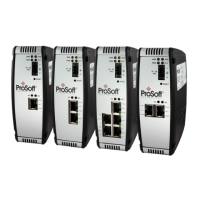PLX3x Series ♦ Multi-Protocol Gateways ASCII Protocol
User Manual
ProSoft Technology, Inc. Page 143 of 215
January 25, 2018
and the Rx message length. If the parameter is set to -1, the port will not
receive data. See Receive Data (page 137) for detailed information on Rx
data structure.
Specifies the starting location in the internal database where the transmit
data will be stored. The buffer holds 130 words, however, the first three
words of the data area define the sequence number, last write byte count
and the Rx message length. If the parameter is set to -1, the port will not
transmit data. See Transmit Data (page 138) for detailed information on Tx
data structure.
Specifies the bits per second rate to use on the port. Enter the baud rate
(bits per second or bps) as a value. You may omit any trailing zeros from
the entered value for the higher bps rates and the gateway firmware will
interpret the setting correctly. For example:
To select 19200 bps, you may enter 192 or 19200.
Valid Values Bits per Second (bps)
110 110 bps
150 150 bps
300 3000 bps
600 6000 bps
1200 1200 bps
2400 2400 bps
4800 4800 bps
96 or 9600 9600 bps
192 or 19200 19200 bps
384 or 38400 38400 bps
576 or 57600 57600 bps
115 or 115200 115200 bps
Specifies the type of parity checking to use. Parity is a simple error
checking algorithm used in serial communication. All devices
communicating through this port must use the same parity setting.
Specifies the number of data bits for each word used by the protocol. All
devices communicating through this port must use the same number of
data bits.
Specifies the number of stop bits. Stop bits signal the end of a character in
the data stream. For most applications, use one stop bit. For slower
devices that require more time to re-synchronize, use two stop bits. All
devices communicating through this port must use the same number of
stop bits.
Specifies the number of milliseconds to delay after Ready To Send (RTS)
is asserted before data will be transmitted.
Specifies the number of milliseconds to delay after the last byte of data is
sent before the RTS modem signal will be set low.
Specifies the handshaking used on the port.
N - No hardware or software handshaking
Y - RTS/CTS hardware handshaking
D - DTR/DSR hardware handshaking
X - XON/XOFF software handshaking.

